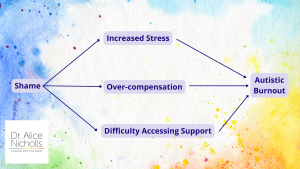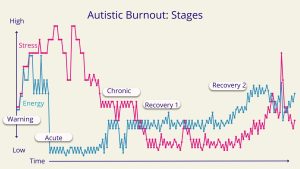I often get asked ‘how can I explain my Autistic Burnout to others?
My answer is that it depends on a few things:
- The context
- How much time do you have for this conversation?
- What is the nature of your relationship with this person? Are they a close friend or more of a casual acquaintance? a health care professional? your boss?
- Is this conversation likely to be overheard or interrupted?
- Is it a busy social event, a work meeting or a 1:1 conversation?
- What you are hoping to achieve by explaining
- Do you want them to understand so they can alter their expectations?
- Are you worried they are judging you for your poor performance at work ?
- Do you want to ask for an accommodation or reasonable adjustment?
- Do you want them to understand your symptoms so they can refer or treat you better?
- How much the other person wants to know
- Have they asked you about your burnout?
- Do they seem genuinely interested?
- Are they asking you to explain why you haven’t done something
- Do they seem interested in your wellbeing or simply agitated that you haven’t done something?
- How safe you feel with them
- Is this someone you feel relaxed around?
- Does this person have a history of being critical or controlling towards you?
- Does this person accept that you are Autistic or have they previously been dismissive or invalidating about your diagnosis?
- Do you feel an increased need to mask around this person?
These factors can help you decide how much you share. Sharing is something we can do to different degrees. I like to imagine sharing as a concept that exists on a continuum with total openness at one end and clearly communicated boundaries, with minimal information at the other end.
To illustrate the ends of this continuum this is what total openness might look like:
Someone you know well and feel safe with as a friend or relative, or someone involved in your care asking because they are genuinely interested. You want them to understand so they can empathise and possibly help you in your recovery.
Depending on the time and situation you might:
- Give them a brief definition of Autistic Burnout and how it affects you personally e.g.:
- I’m struggling to do basic tasks around the house at the moment due to Autistic Burnout. Autistic Burnout isn’t an official diagnosis but it is a common experience in the Autistic Community. It is a period of prolonged fatigue and loss of skills caused by too much exposure to stress and too little support or opportunity to recover.
- Direct them to a resource where they can find out more e.g:
For the other end of the continuum, this is what clearly communicated boundaries with minimal information might look like:
Someone you do not feel safe with, who is not interested, or is only asking why you can’t do something out of frustration that you are not doing it rather than a wish to understand. You might find this person to be critical, argumentative or defensive.
While you may wish you could get this person to understand, this is unlikely to be productive and your efforts may in fact put you at greater risk of being criticised or rejected.
If this person is someone you have to interact with you may still need to communicate that you can not do something, or that you need something. If this is the case, try to give them a minimal amount of information necessary in order to communicate a boundary or request. For example:
- I’m sorry I don’t have capacity for this right now
- I’m not feeling well and I need to leave
- I find I am more productive when…XYZ
- My capacity is currently limited by personal issues/ a health problem, please can we postpone/cancel/make changes
- Here is my request for reasonable adjustments
Of course, there will be lots of people or situations that fall between these two extremes.
A common example is a healthcare professional who doesn’t believe in Autistic Burnout but whom you have reasonable rapport with and still need some support or treatment from.
In these cases you might chose to describe your most disabling symptoms or ask for specific supports you think would help, e.g:
- My stress levels were really high for a long time and I now feel exhausted and stressed by even the smallest things
- My energy levels are really low and I’m struggling to do basic tasks
- I need some help to find a way of resting
- I’m feeling exhausted, please can I have some help with pacing?
- I’m really struggling with my sensory needs at the moment, please can you (name adjustment to sensory environment)
Conclusion
There are many situations and reasons we might want to explain our Autistic Burnout to others.
There are many factors to consider when deciding how much to share including the context, what you are hoping to achieve by explaining, how much the other person wants to know and how safe you feel with them.
If you don’t feel safe with someone and don’t feel they want to understand then it may be wiser to give minimal information and communicate clear boundaries around what you feel able to do or adjustments you need.
For people who you feel safe with, who really want to understand and empathise you might chose to give more information about what Autistic Burnout is and how it affects you specifically.
Please be aware that sharing this information about yourself may make you feel vulnerable, but with people who genuinely care for you it can increase understanding and feelings of connection.
Please also be aware that you don’t owe anyone an explanation, and if you feel that the tone of the conversation is a critical one then sharing more information may not be wise. In these situations communicating minimal relevant information and clear boundaries may be more appropriate.
Discussions about communicating Autistic Burnout and needs for adjustments come up regularly in Authenticity: The Course and Community. You would be very welcome to join us.
I am an Autistic Clinical Psychologist specialising in Autistic Burnout if you would like to know more about my work please check out my:
- Mailing list community for people who want to receive helpful information and resources about Autistic Burnout.
- Free short course on How to Break the Cycle of Autistic Burnout (link goes straight to registration page)
- Authenticity Basecamp: A 90 day support programme for people in the early stages of recovering from Autistic Burnout who want to get calmer, clearer and more supported.
- Authenticity: The Course and Community: For late-realised, high-masking Autistic adults who want to build more sustainable, authentic lives and break free of the cycle of Autistic Burnout for good.











